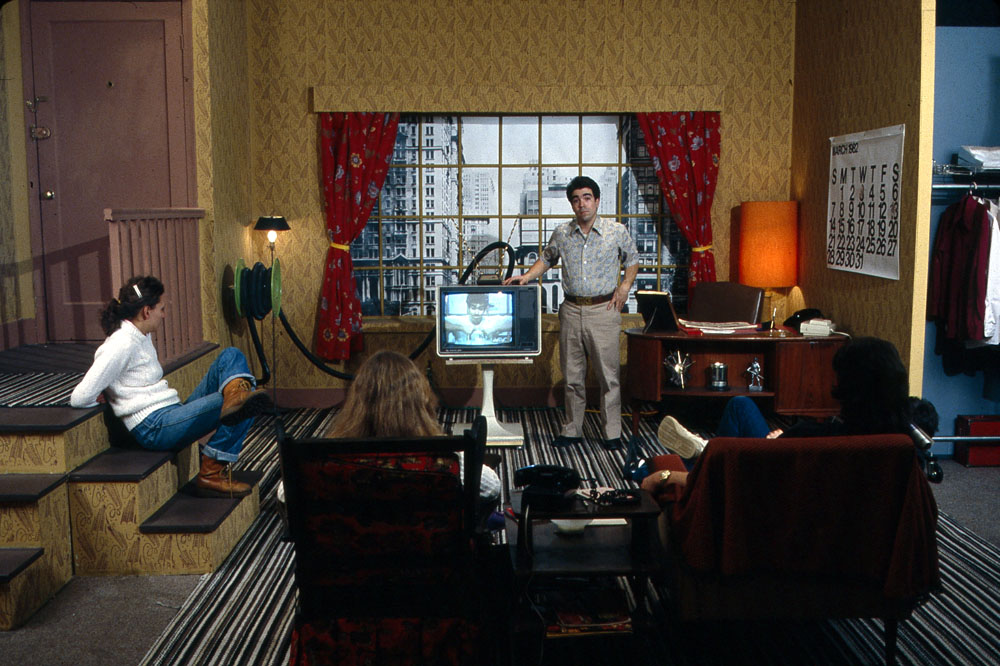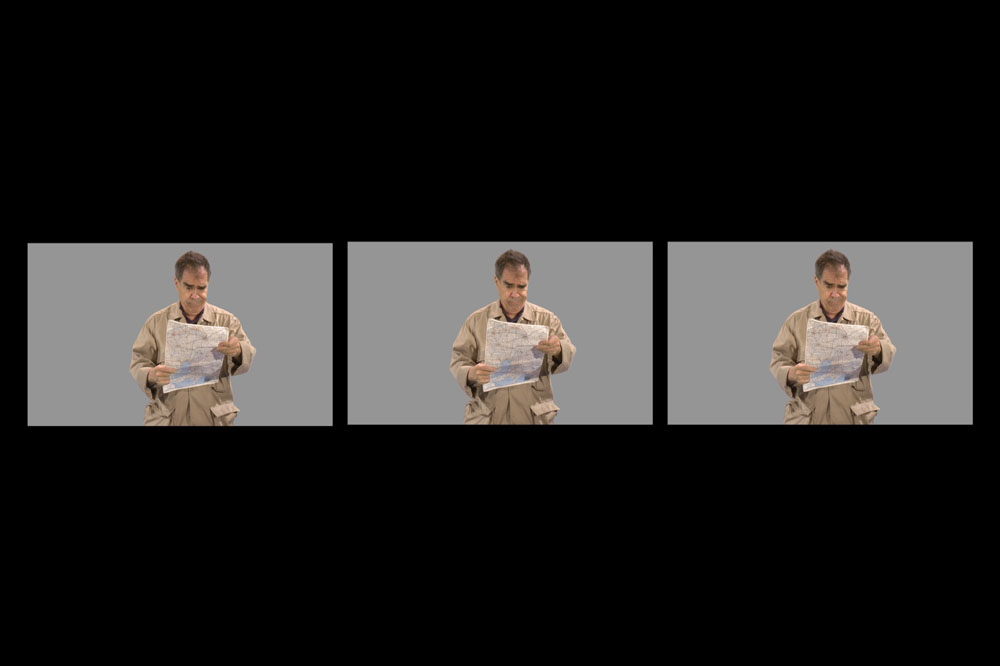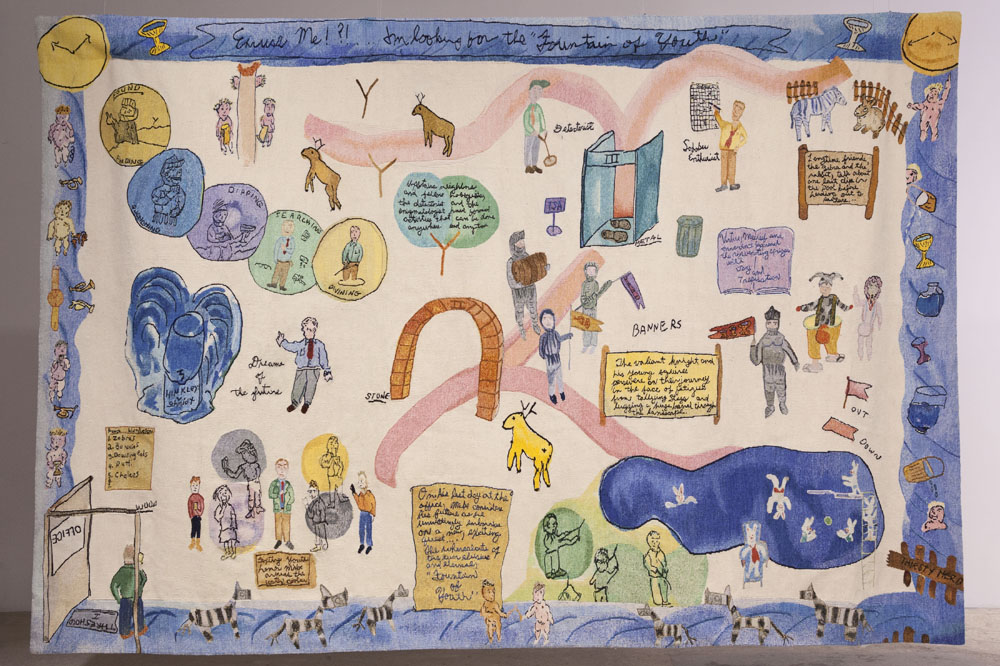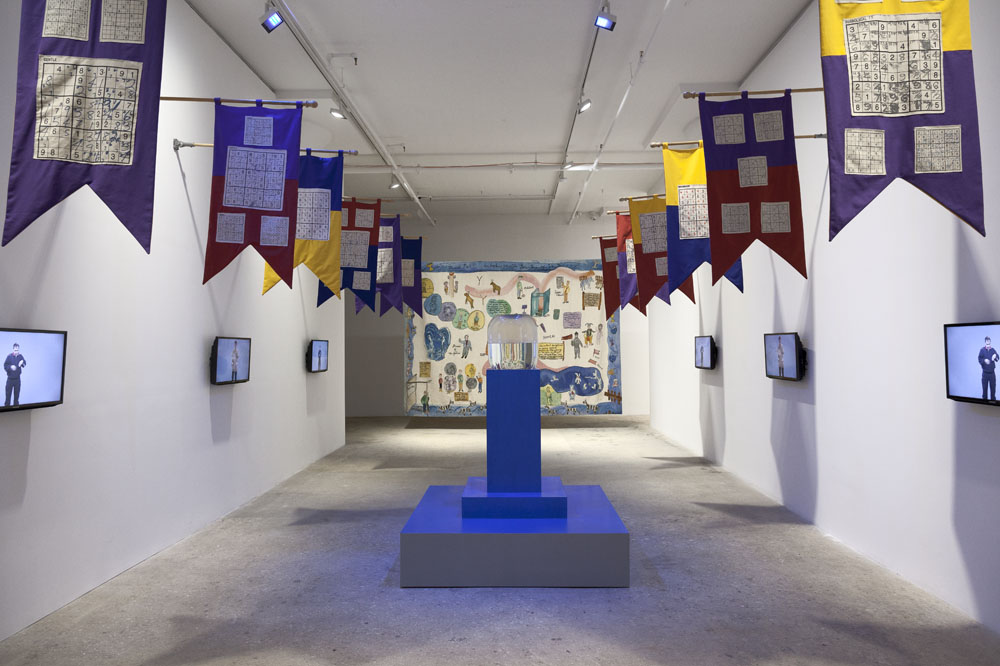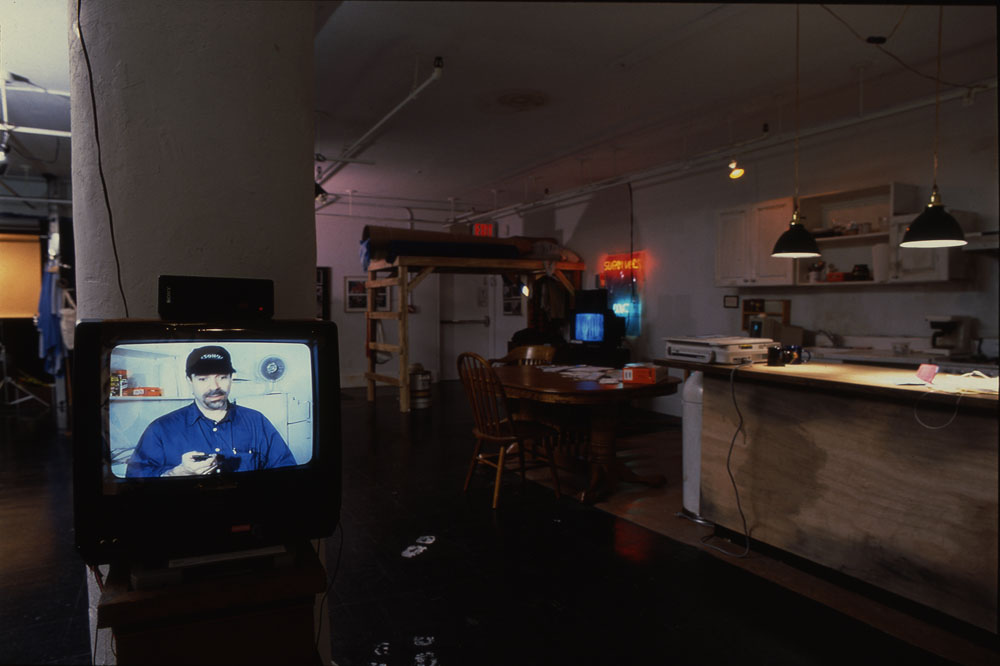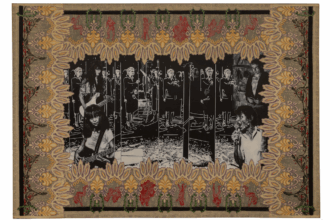Michael Smith belongs to the first wave of artists who made extensive use of mass-media imagery and formats in their work. His conceptually-minded peers in the so-called Pictures Generation (including Cindy Sherman, Sherrie Levine, and Jack Goldstein) employed a wide variety of aesthetic strategies, but even among this diverse group, Smith’s satirical work has always stood out as an anomaly. Indeed, a carefully-calibrated, slightly-out-of-sync quality has long been one of his signatures – an approach that’s both distinguished his work and diminished the attention it’s been paid.
Many of Smith’s contemporaries were influenced by punk and other sub-cultural movements in the late 1970s, taking the route of excess, exaggeration, and provocation when critically engaging with popular media. Figures like Paul McCarthy, Raymond Pettibon, and Mike Kelley continued to mine confrontational aesthetics throughout their careers, often in more amplified and baroque forms as their notoriety and budgets increased. At times this proved a productive strategy, as in the disorienting sensory overkill of Kelley’s late installations. However, in the contemporary context, in which “subversion” has become a genre more than an act, it can often seem like the path of least resistance. Consider, for instance, McCarthy’s use of obscene spectacle with his lurid explorations of pop-culture mythology in WS and Rebel Dabble Babble (both 2013), or Richard Prince’s attempt to out-creep the kids with his Instagram re-prints, New Portraits (2014). Whatever its merits in terms of exposing societal hypocrisies and blind spots, the bleed-the-beast approach, which intentionally blurs the line between criticality and collusion, increasingly serves artists who wish to partake in the very culture they’re supposedly critiquing.
Smith has explored some similar thematic territory as the artists mentioned above. In fact, one of his best-known works was a collaboration with Kelley. That project, A Voyage of Growth and Discover (2009), revolved around Smith’s long-running character Baby Ikki, a man-sized infant in a diaper and sunglasses who Smith performs with unsettling verisimilitude (Kelley and Smith sent Baby Ikki to Burning Man, testing the limits of the festival’s principal of “radical self-expression”). There is a punk-confrontational aspect to Baby Ikki, but it has more to do with challenging conventions of public behavior and interaction than media culture.
Although Smith has been performing Baby Ikki since the late 1970s, the majority of his work has revolved around another character, a painfully normal American everyman named “Mike.” It’s mainly through Mike that Smith has explored popular media. However, in contrast to some of his peers, Smith’s media appropriations and incursions have focused on banality and failure rather than indulgence and spectacle. With Mike as his avatar/Trojan horse, Smith has aimed not to shock but to underwhelm, deflating the persuasive power of the media while exposing the fallacies of its appeal. Smith’s slow-burn methodology doesn’t stoke extreme responses or court controversy, but his work has been consistently original and incisive, especially in its cumulative impact.
An archetypal naïf, Mike is the definition of a static character, but Smith has proven remarkably adept at creating new situations and contexts for him that continue to yield fresh insights. Smith’s latest “Mike” exhibition, Excuse me!?!…I’m looking for the “Fountain of Youth” at Greene Naftali, offered an iteration of Mike that built on the character’s previous appearances while also extending Smith’s thematic reach in surprising ways. The show also included a brief but significant appearance by Baby Ikki – a rare instance in which the two characters have been featured in the same work.
Mike has often been presented as an artist or entrepreneur who is frequently launching new creative/business endeavors that make use of emerging media. Smith’s satirical method has generally been to let Mike articulate his doomed plans and comically low-ambition fantasies in such a way that their pathetic nature becomes transparent. As curator Annette DiMeo Carlozzi puts it, Mike is “a kind of ever-hopeful Candide, adrift in a world of rapid technological advances that he seems incapable of fully comprehending, and stymied by the depersonalization and isolation that have accompanied late-twentieth-century life.” Mike seems to fail perpetually but never spectacularly, enduring his mediocrity through a mixture of obliviousness, delusion, and futile industriousness. (It’s no surprise that Beckett is one of Smith’s oft-cited influences.)
Smith’s satirical target is not Mike himself but the cultural values by which he too innocently abides. Mike is an affably empty cypher for the vacant notions about life that he’s inherited from the world around him, and which he ineptly tries to put to practice. Smith’s video works are often ostensibly self-produced by Mike, such as Interstitial, the artworld talk show Mike hosted on the public-access television in the late 1980s. Other works play more like TV-mediated expressions of Mike’s fantasies about himself and his humdrum life, as with the music video Go For It Mike (1985) and the commercial spoof MIKE (1987). Smith is a master of skewering various media formats by filtering them through Mike’s uncomplicated psyche and limited talents.
Although the “Mike” works usually have a narrative component, there isn’t any overarching story linking them all together. However, there has been a gradual shift in tone over the years. Smith’s style of performing Mike has become subtler and more nuanced, and his investment in the character seems to have deepened. Mike’s appearances in the last two decades have usually taken the form of elaborate installations that come with extensive fictional back-stories, as with Open House (1999) and QuinQuag (2001). Projects like these downplay the earlier works’ absurd stylization of media formats, instead creating more believable simulations for Mike to inhabit while also placing him in more specific social contexts. One factor in this shift may be the diminished role of television in American society. In the 1980s and ‘90s, Mike’s view of the world, and our view of him, was mediated through TV conventions. This has clearly become a less relevant tactic. While Smith’s later projects have involved the internet, he seems to have chosen to focus more on Mike’s character than the medium itself. Mike has increasingly been presented with more pathos, and his imminent failures have become more realistic and affecting. Smith’s satire, by turn, has become gentler as well as denser, filled with insidious details about Mike’s world, and ours.
Excuse me!?!…I’m looking for the “Fountain of Youth” continued further in this direction while simultaneously making something of a departure. Through thematically-related works across various media, a loose narrative emerged from the exhibition: Mike, now an office worker and Sudoku enthusiast, embarks on a vacation, possibly a retirement trip, which becomes linked in various ways to the mythological search for the fountain of youth. On the more literal side of this conceit, two photo-essays present the puzzled Mike visiting youth-themed tourist destinations – a faux-historical site in Florida called the Fountain of Youth, and the São Paulo theme park KidZania, which offers a child-sized replica of a contemporary metropolis. However, the centerpiece of the show was a three-act ballet on video, which offered a more abstract, hallucinatory narrative in which Mike competes with younger co-workers around the office water-cooler, imagines himself as a medieval knight searching for the fountain of youth, and struggles to pass through airport security on vacation.
The intentionally amateurish ballet/video mixes middle-aged melancholy and befuddlement with awkward adolescence, featuring an ensemble of young apprentice dancers (apart from Smith, who is 64, no one in the cast looks much older than twenty). It plays like an anxiety dream about aging in which Mike finds himself in a PBS adaptation of a community-theater ballet starring an all-teenaged cast that refuses to cooperate with the plot he thinks he’s following.
Much of the rest of the exhibition presents work loosely related to the ballet. The main gallery space was decorated as a medieval foyer, with a sculpture of a water-cooler flanked by large medieval pennons decorated with images of Sudoku games. Hanging at one end of the foyer was a large wool tapestry containing a picture-book depiction of Mike’s vacation/quest as if it was an old fable. On the walls beneath the pennons were flat-screen monitors showing video tableaus of Mike searching his pockets for his reading glasses, struggling to unfold a tourist map, untangling his earphones, etc. Smith’s perfectly-timed deadpan performances elevate these routine gestures of a solitary man in public into Tati-esque comic pantomimes of loneliness and unease.
The exhibition had a more ageless feel than usual for Smith. The main theme seemed to be the infantilizing process of aging – the expectations and fantasies that accumulate as one leaves the workforce, gives up their social function, and enters the nebulous post-adulthood stage of life, with its many similarities between childhood and adolescence. For someone like Mike, whose identity is so directly linked to his perceived social role, this process would be especially perilous and transformative. What emerged was a portrait of a character for whom every journey (to the water-cooler, out the office door, through airport security) is a quasi-mythical quest for discovery and renewal, a veiled search for the fountain of youth. As such, every trip, every effort, is doomed to fail. Failure has been one of the central themes of Smith’s “Mike” work, and here it took on more cosmic/existential overtones than ever before.
This was signaled in the exhibition by a crucial moment in Act 2 of the ballet when Mike discovers the fountain of youth and is transformed into Baby Ikki. Within the ballet, this functions as a kind of nightmare wish-fulfillment: Ikki is no one’s ideal of youth. However, in the broader context of Smith’s body of work, the moment brings his two long-running personae together full circle. Mike and Ikki have always been flipsides of each other, representing opposite kinds of innocence. Mike is receptive, Ikki is reactive. Mike is socialized, embedded in contemporary America; Ikki has no language or culture. Mike does what he thinks he’s supposed to do, and looks to the future; Ikki does what he wants impulsively in the moment. But both have always been solitary figures as well as blank slates for whom any kind of lasting meaning remains an elusive concept, if not a pressing concern. Now these similarities seem to be overtaking the differences as aging as Mike approaches the other side of the oblivion from which the Baby recently emerged.
This new phase of Mike’s existence was reflected by a striking change from his previous appearances: this time he was completely silent. Without his characteristically upbeat but unconvincing verbiage, Mike shakes off much of the ironic characterization that definitively separated him from Smith and that provided some plausible deniability for viewers disinclined to identify too closely with his sad-sack ways. But if Mike’s silence made it harder to feel superior to him, it also put him at something of a remove. For those of us who’ve become accustomed to regarding Mike as being more or less without an interior life, this was rather unsettling. On the other hand, for anyone unfamiliar with Smith’s previous work, the character’s silence, along with the muted quality of the show as a whole, may very well have registered as curiously sedate, if elaborately so. This is the trade-off of Smith burrowing so deeply into the character of Mike and his world. The richness of the work conceals rather than advertises itself.
One of the paradoxes of Smith’s “Mike” works is that while they are usually positioned as comically out-of-step with the contemporary, they often come to seem prescient, in retrospect. When smart phones show up in Excuse me!?! … I’m looking for the “Fountain of Youth,” they seem both baffling and quaint, glowing toy-like objects whose elevated purpose feels like a mystery from another time. This, of course, is how they might well seem to a 64-year-old retiree like Mike, but it’s also how they’ll surely appear to everyone a few decades from now. By filtering the present through Mike’s hapless perspective, Smith portrays his historical moment the way it will inevitably appear to the future – as obsolete.

